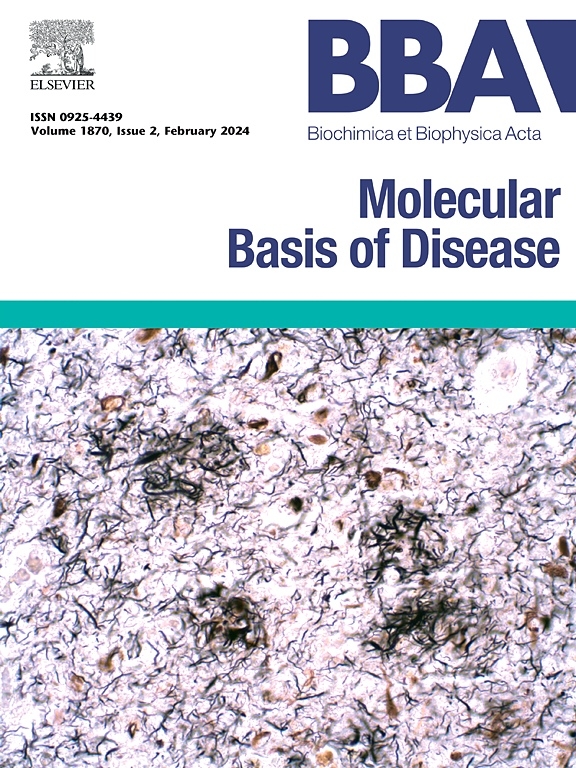远端缺血预处理通过ARE途径增强脑缺血再灌注损伤大鼠的抗氧化能力
IF 4.2
2区 生物学
Q2 BIOCHEMISTRY & MOLECULAR BIOLOGY
Biochimica et biophysica acta. Molecular basis of disease
Pub Date : 2025-08-21
DOI:10.1016/j.bbadis.2025.168010
引用次数: 0
摘要
远端缺血预处理(RIPC)是一种保护策略,其中一个器官的短暂缺血和再灌注可以保护另一个器官。这可以通过体液反应、转录过程或两者共同介导。这些保护作用被认为是由于细胞对缺血的耐受性增强。本研究探讨了RIPC对大脑中动脉闭塞(MCAO)大鼠的保护作用。方法应用弹性橡胶止血带对右后肢进行短暂性缺血治疗。这包括每个周期收紧和释放止血带15分钟(2个周期30分钟或4个周期60分钟)。然后在肢体缺血后12或24 h诱导MCAO并维持90 min。MCAO后7天,评估神经行为结果和脑梗死体积。氧化应激标志物,包括丙二醛、髓过氧化物酶和二氢乙啶,以及抗氧化参数,如谷胱甘肽(GSH)、谷胱甘肽/谷胱甘肽比值和γ-谷氨酰半胱氨酸连接酶(GCS),进行了评估。western blotting和免疫荧光法分析Nrf-1和Nrf-2的表达水平。结果ripc治疗60分钟(4个周期),而非30分钟,可显著减少梗死面积并改善行为结果。此外,观察到中性粒细胞浸润、脂质过氧化和神经元变性的减少。与对照组相比,RIPC 60 min后Nrf1和Nrf2水平以及GSH、HO-1和GCS活性显著升高。结论后肢ripc作用60min对MCAO模型大鼠具有一定的神经保护作用。RIPC可能是临床脑卒中管理的潜在辅助策略。本文章由计算机程序翻译,如有差异,请以英文原文为准。
Remote ischemic preconditioning enhances antioxidant capacity in cerebral ischemia–reperfusion injured rats via the ARE pathway
Background
Remote ischemic preconditioning (RIPC) is a protective strategy in which transient ischemia and reperfusion in one organ confers protection to another. This can be mediated by humoral responses, transcriptional processes, or both. These protective effects are hypothesized to result from enhanced cellular tolerance to ischemia. Herein, we investigated the protective effects of RIPC in middle cerebral artery occlusion (MCAO) rats.
Methods
RIPC was performed by applying an elastic rubber tourniquet to the right hindlimb to induce transient ischemia. This involved tightening and releasing the tourniquet for 15 min per cycle (2 cycles for 30 min or 4 for 60 min). MCAO was then induced 12 or 24 h post-limb ischemia and maintained for 90 min. Seven days after MCAO, neurobehavioral outcomes and brain infarction volumes were evaluated. Oxidative stress markers, including malondialdehyde, myeloperoxidase, and dihydroethidium, alongside antioxidant parameters such as glutathione (GSH), the GSH/GSSG ratio, and γ-glutamyl cysteine ligase (GCS), were assessed. The expression levels of Nrf-1 and Nrf-2 were analyzed by western blotting and immunofluorescence.
Results
RIPC for 60 min (4 cycles), but not for 30 min, significantly reduced infarct volumes and improved behavioral outcomes. In addition, reductions in neutrophil infiltration, lipid peroxidation, and neuronal degeneration were observed. Nrf1 and Nrf2 levels and GSH, HO-1, and GCS activities were significantly elevated after RIPC for 60 min compared to the control.
Conclusion
RIPC in the hind limbs for 60 min leads to neuroprotection in a rat MCAO model. RIPC may be a potential adjunctive strategy for clinical stroke management.
求助全文
通过发布文献求助,成功后即可免费获取论文全文。
去求助
来源期刊
CiteScore
12.30
自引率
0.00%
发文量
218
审稿时长
32 days
期刊介绍:
BBA Molecular Basis of Disease addresses the biochemistry and molecular genetics of disease processes and models of human disease. This journal covers aspects of aging, cancer, metabolic-, neurological-, and immunological-based disease. Manuscripts focused on using animal models to elucidate biochemical and mechanistic insight in each of these conditions, are particularly encouraged. Manuscripts should emphasize the underlying mechanisms of disease pathways and provide novel contributions to the understanding and/or treatment of these disorders. Highly descriptive and method development submissions may be declined without full review. The submission of uninvited reviews to BBA - Molecular Basis of Disease is strongly discouraged, and any such uninvited review should be accompanied by a coverletter outlining the compelling reasons why the review should be considered.

 求助内容:
求助内容: 应助结果提醒方式:
应助结果提醒方式:


